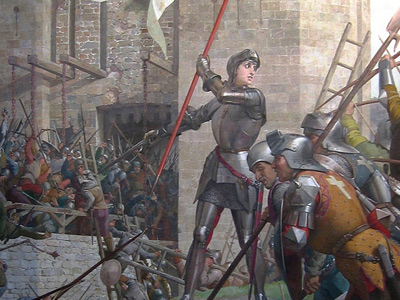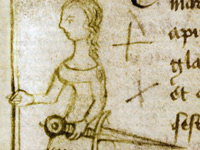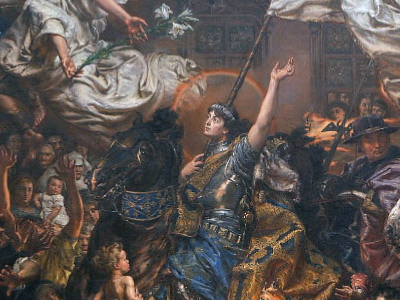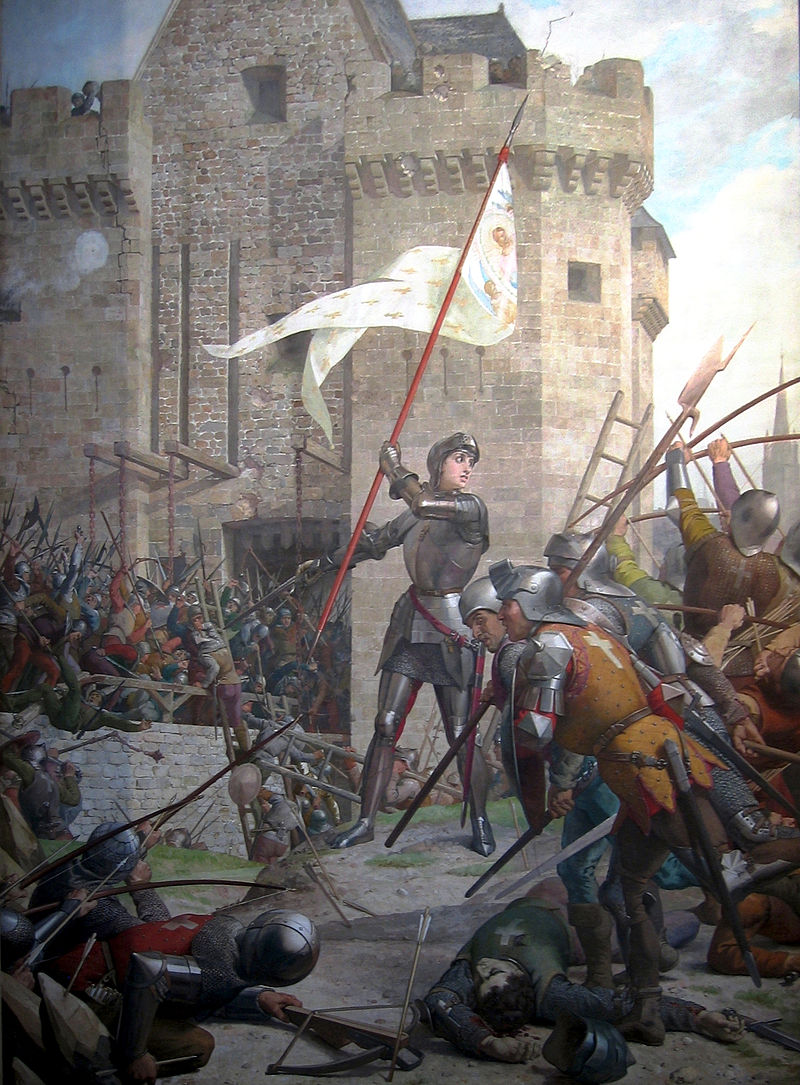Siege of Orléans (1428–1429)

Preparations
State of the conflict
After the brief fallout over Hainaut in 1425-26, English and Burgundian arms renewed their alliance and offensive on the Dauphin's France in 1427. The Orléanais region southwest of Paris was of key importance, not only for controlling the Loire river, but also to smoothly connect the English area of operations in the west and the Burgundian area of operations in the east. French arms had been largely ineffective before the Anglo-Burgundian onslaught until the siege of Montargis in late 1427, when Étienne de Vignolles ("La Hire") and John of Orléans, Count of Dunois ("the Bastard of Orléans") managed to successfully force the siege to be lifted. The relief of Montargis, the first effective French action in years, emboldened sporadic uprisings in the thinly-garrisoned English-occupied region of Maine to the west, threatening to undo recent English gains.
However, the French The Kingdom of France is the historiographical name or umbrella term given to various political entities of France in the medieval and early modern period. It was one of the most powerful states in Europe since the High Middle Ages. It was also an early colonial power, with possessions around the world. Colonial conflicts with Great Britain led to the loss of much of its North American holdings by 1763. The Kingdom of France adopted a written constitution in 1791, but the Kingdom was abolished a year later and replaced with the First French Republic. failed to capitalize on the aftermath of Montargis, in large part because the French court was embroiled in an internal power struggle between the constable Arthur de Richemont and the chamberlain Georges de la Trémoille, a new favorite of the Dauphin Charles. John of Dunois, La Hire and Poton de Xaintrailles were partisans of La Trémoille, while Charles de Bourbon (Count of Clermont) (son of the imprisoned duke of Bourbon), the marshal Jean de Brosse (Sieur de Boussac) and John Stewart of Darnley (head of the Scottish auxiliary forces), were lined up with the constable. The inner French conflict had reached such a point that their partisans were fighting each other in the open field by mid-1428.
The Kingdom of France is the historiographical name or umbrella term given to various political entities of France in the medieval and early modern period. It was one of the most powerful states in Europe since the High Middle Ages. It was also an early colonial power, with possessions around the world. Colonial conflicts with Great Britain led to the loss of much of its North American holdings by 1763. The Kingdom of France adopted a written constitution in 1791, but the Kingdom was abolished a year later and replaced with the First French Republic. failed to capitalize on the aftermath of Montargis, in large part because the French court was embroiled in an internal power struggle between the constable Arthur de Richemont and the chamberlain Georges de la Trémoille, a new favorite of the Dauphin Charles. John of Dunois, La Hire and Poton de Xaintrailles were partisans of La Trémoille, while Charles de Bourbon (Count of Clermont) (son of the imprisoned duke of Bourbon), the marshal Jean de Brosse (Sieur de Boussac) and John Stewart of Darnley (head of the Scottish auxiliary forces), were lined up with the constable. The inner French conflict had reached such a point that their partisans were fighting each other in the open field by mid-1428.
Advertisement

These books are available for download with iBooks on your Mac or iOS device, and with iTunes on your computer. Books can be read with iBooks on your Mac or iOS device.

These books are available for download with iBooks on your Mac or iOS device, and with iTunes on your computer. Books can be read with iBooks on your Mac or iOS device.
( Click image to enlarge)
The English availed themselves of French paralysis to raise fresh reinforcements in England The Kingdom of England was a sovereign state on the island of Great Britain from about 927, when it emerged from various Anglo-Saxon kingdoms, until 1 May 1707, when it united with Scotland to form the Kingdom of Great Britain. The Viking invasions of the 9th century upset the balance of power between the English kingdoms, and native Anglo-Saxon life in general. The English lands were unified in the 10th century in a reconquest completed by King Æthelstan in 927. in early 1428, raising a new force of 2,700 men (450 men-at-arms and 2,250 longbowmen), brought over by Thomas Montacute (Earl of Salisbury). These were bolstered by new levies raised in Normandy and Paris, and joined by auxiliaries from Burgundy and vassal domains in Picardie and Champagne, to a total strength possibly as great as 10,000. At the council of war in the Spring of 1428, the English regent John Duke of Bedford determined the direction of English arms would be towards the west, to stomp out the fires in the Maine and lay siege to Angers. The city of Orléans was not originally on the menu - indeed, Bedford had secured a private deal with Dunois, whose attentions were focused on the Richemont-La Trémoille conflict, then raging violently in the Berri. As Charles, Duke of Orléans was at the time in English captivity, it would have been contrary to the customs of knightly war to seize the possessions of a prisoner. Bedford agreed to leave Orléans alone, but, for some reason, changed his mind shortly after the arrival of English reinforcements under Salisbury in July 1428. In a memorandum written in later years, Bedford expressed that the siege of Orléans "was taken in hand, God knoweth by what advice", suggesting it was probably Salisbury's idea, not his.
The Kingdom of England was a sovereign state on the island of Great Britain from about 927, when it emerged from various Anglo-Saxon kingdoms, until 1 May 1707, when it united with Scotland to form the Kingdom of Great Britain. The Viking invasions of the 9th century upset the balance of power between the English kingdoms, and native Anglo-Saxon life in general. The English lands were unified in the 10th century in a reconquest completed by King Æthelstan in 927. in early 1428, raising a new force of 2,700 men (450 men-at-arms and 2,250 longbowmen), brought over by Thomas Montacute (Earl of Salisbury). These were bolstered by new levies raised in Normandy and Paris, and joined by auxiliaries from Burgundy and vassal domains in Picardie and Champagne, to a total strength possibly as great as 10,000. At the council of war in the Spring of 1428, the English regent John Duke of Bedford determined the direction of English arms would be towards the west, to stomp out the fires in the Maine and lay siege to Angers. The city of Orléans was not originally on the menu - indeed, Bedford had secured a private deal with Dunois, whose attentions were focused on the Richemont-La Trémoille conflict, then raging violently in the Berri. As Charles, Duke of Orléans was at the time in English captivity, it would have been contrary to the customs of knightly war to seize the possessions of a prisoner. Bedford agreed to leave Orléans alone, but, for some reason, changed his mind shortly after the arrival of English reinforcements under Salisbury in July 1428. In a memorandum written in later years, Bedford expressed that the siege of Orléans "was taken in hand, God knoweth by what advice", suggesting it was probably Salisbury's idea, not his.

Orléans in 1428-9, the time of the siege

Orléans in 1428-9, the time of the siege
( Click image to enlarge)
Salisbury's approach
Between July and October, the Earl of Salisbury swept through the countryside southwest of Paris - recovering Nogent-le-Roi, Rambouillet and the area around Chartres. Then, rather than continuing southwest to Angers, Salisbury turned abruptly southeast towards Orléans instead. Pressing towards the Loire, Salisbury seized Le Puiset and Janville (with some difficulty) in August. From there, rather than descending directly on Orléans from the north, Salisbury skipped over the city to seize the countryside west of it. He reached the Loire river at Meung-sur-Loire, which he promptly seized (a detachment of his men crossed the river then to plunder the abbey of Cléry). He pressed a little downriver, in the direction of Blois, to take the bridge and castle of Beaugency. Salisbury crossed the Loire at the point, and turned up to approach Orléans from the south. Salisbury arrived at Olivet, just one mile south of Orléans, on October 7. In the meantime, an English detachment, under John de La Pole, had been sent to seize the regions upriver, east of Orléans: Jargeau fell on October 5, Châteauneuf-sur-Loire immediately after, while further upriver, the Burgundians took Sully-sur-Loire. Orléans was cut off and surrounded.
Manning the defenses of Orléans, John of Dunois had watched the tightening English noose and took care to prepare the city for siege. Dunois correctly anticipated that the English would aim for the bridge, nearly 1⁄4 mile (400 m) long, that led from the south shore of the Loire into the center of the city of Orléans on the north shore. The bridge passed over the riverine island of St. Antoine, an optimal location for Salisbury to position English cannon within range of Orléans city center. At the southern end of the bridge was a turreted gatehouse, Les Tourelles, which stood in the river, connected by a drawbridge to the southern bank. Dunois rapidly erected a large earthwork bulwark (Boulevart) on the south shore itself, which he packed with the bulk of his troops, thus creating a large fortified complex to protect the bridge. Just across from the Boulevart was an Augustinian friary, which could be used as a flanking firing position on any approach to the bridge, although it seems Dunois decided not to make use of it. On his orders, the southern suburbs of Orléans were evacuated and all structures leveled to prevent giving the English cover.
HISTORY

RESOURCES
This article uses material from the Wikipedia article "Siege of Orléans", which is released under the Creative Commons Attribution-Share-Alike License 3.0.
© Stories Preschool. All Rights Reserved.










